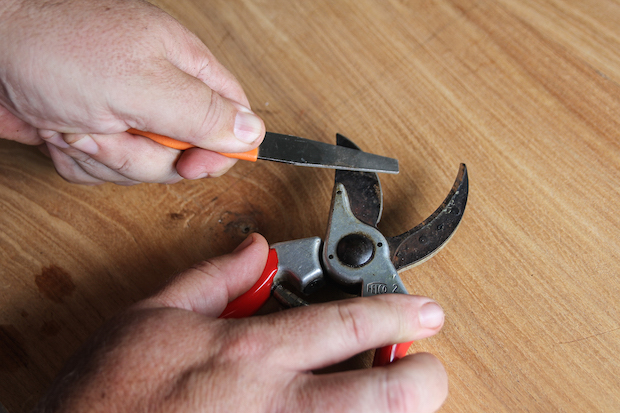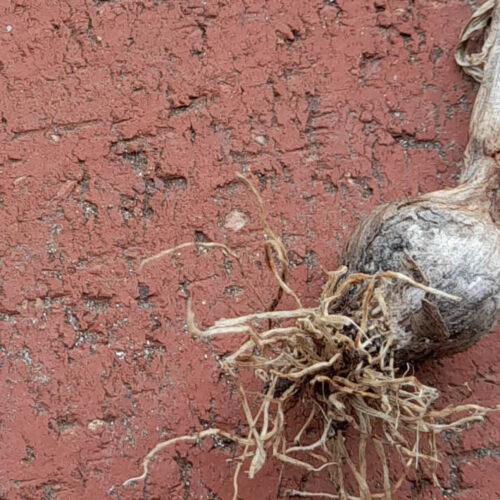How to sharpen your tools
2018-04-05T03:34:52+10:00
Well-maintained tools make gardening jobs safer and easier. Justin Russell shows how to keep them sharp.
Put simply, we all need to invest in good tools, learn how to use them well and maintain them. The latter point is often casually overlooked. I’m guilty of getting distracted or lazy (or both) and neglecting my tools. Let the tips that follow serve as a gentle reminder to us all.
Sharpening
Confucius was on to something when he said “the mechanic who would perfect his work must first sharpen his tools”. A sharp tool is efficient and safe to use. The fact that it’s efficient is obvious – sharp tools cut more cleanly, take less time, and cause less damage to plant tissue – but the idea that sharpness equals safety can seem counterintuitive. Wouldn’t a razor-sharp grafting knife be more likely to slice off a gardener’s finger than a blunt knife?
Absolutely not. A sharp tool requires less force to make a cut, offering greater control and reducing the chances of slipping or overcutting. Just as a chef sharpens their knife before they start preparing for a lunch service, a gardener should at least sharpen important tools before every gardening session. If you find yourself hacking and sawing away at plant wood instead of cleanly snipping and slicing, stop what you’re doing, grab a sharpener and renew that tool’s cutting blade.
Sharpening how to’s
Small hand tools such as grafting knives, harvesting knives, secateurs and loppers are most easily sharpened with a handheld diamond sharpener. Slide the diamond face across the bevelled blade of the hand tool until the desired sharpness is achieved. Make smooth strokes at a consistent angle to avoid rounding the bevel. Note that some blades have a single bevel on one side only, others have a bevel on both sides. This is a design feature, which implies that single- sided blades shouldn’t be converted to double sided and vice versa.
Larger tools such as spades, axes and hoes can be sharpened with either a bench grinder, hand held grinder or a metal file. Unless a blade is very dull or dented (in which case I use a grinder) my preferred tool for this job is a bastard file. The term “bastard” refers to the file’s cutting surface, which is between “coarse” or “second cut”. It offers a good balance, removing decent amounts of steel quickly, without leaving the finished surface too rough. When using electric grinders, be safe. Ensure the tools being sharpened are held securely with clamps or a vice and wear safety gear as necessary.
Pruning saws work much better sharp, but sharpening them is a tricky job. My advice: Ask at your local nursery or hardware store if they offer a sharpening service. Professional sharpening is relatively cheap and well worth it.
Oiling and lubricating
Have you ever had a finger impaled by a splinter simply from picking up a garden tool with a weathered timber handle? I have, and I can assure you, it’s not a pleasant experience. The only reason it ought to happen is because of neglect (guilty, Your Honour) on the part of the gardener. For the sake of longevity and your fingers, take some time at least every winter, better still once per season, to sand and oil timber handles. It’s a quick job, smells delicious thanks to the oil, and makes for a handle with a beautiful smooth patina.
It’s also vital to regularly lubricate tools and machinery that have moving parts. Cease doing this and metal parts are likely to seize. Treat your tools as you would costly items like your mower or car – saving on repairs or replacements.
Oiling and lubricating how to’s
Cut a sheet of coarse sandpaper (around 60 grit) into a piece about 15cm square and simply run this up and down the handle until the timber is smooth. You can finish with a finer grit sandpaper if you like, but I don’t. A bit of grip is essential. With the timber sanded, pour a small amount of oil on a rag and slide this up and down the handle until the surface is entirely covered. Boiled linseed oil is traditional, cheap and widely available, but any exterior timber oil is fine. Wipe off any excess oil, allow the handle to dry and you’re good to go.
Lubricating tools is as simple as giving the moving parts a spray or squirt with a lubricating fluid. Focus your attention on joins, springs and blades, giving the tool a squeeze or flex as you go to ensure the fluid gets right in and does its job.
I generally use a penetrating fluid such as WD40 or RP7 to lubricate my tools, but specialised oils are available from nurseries and hardware stores. If tools are particularly gummed up with plant sap or really dirty, they will need to be pulled apart, cleaned, reassembled and then lubricated.
For more on quality tools for gardening, click here






